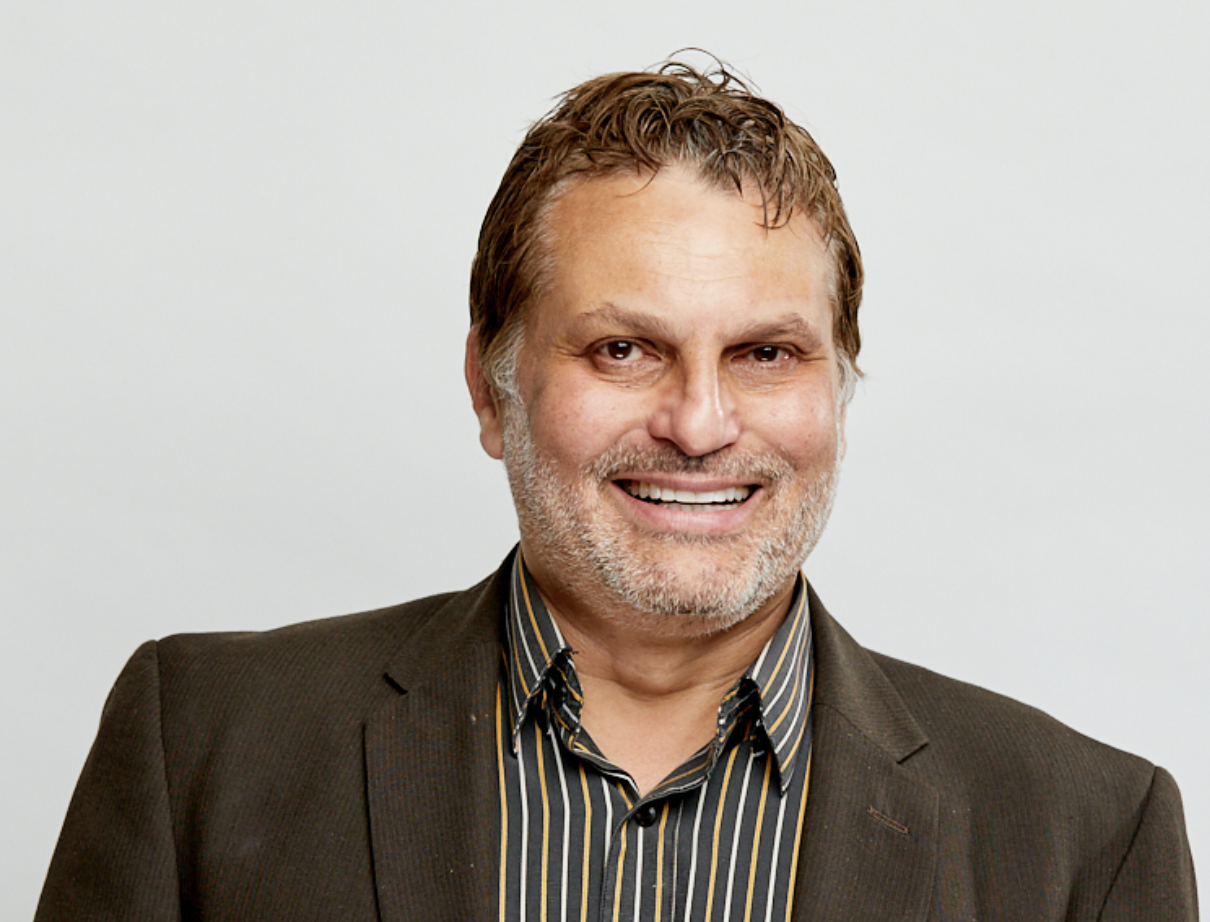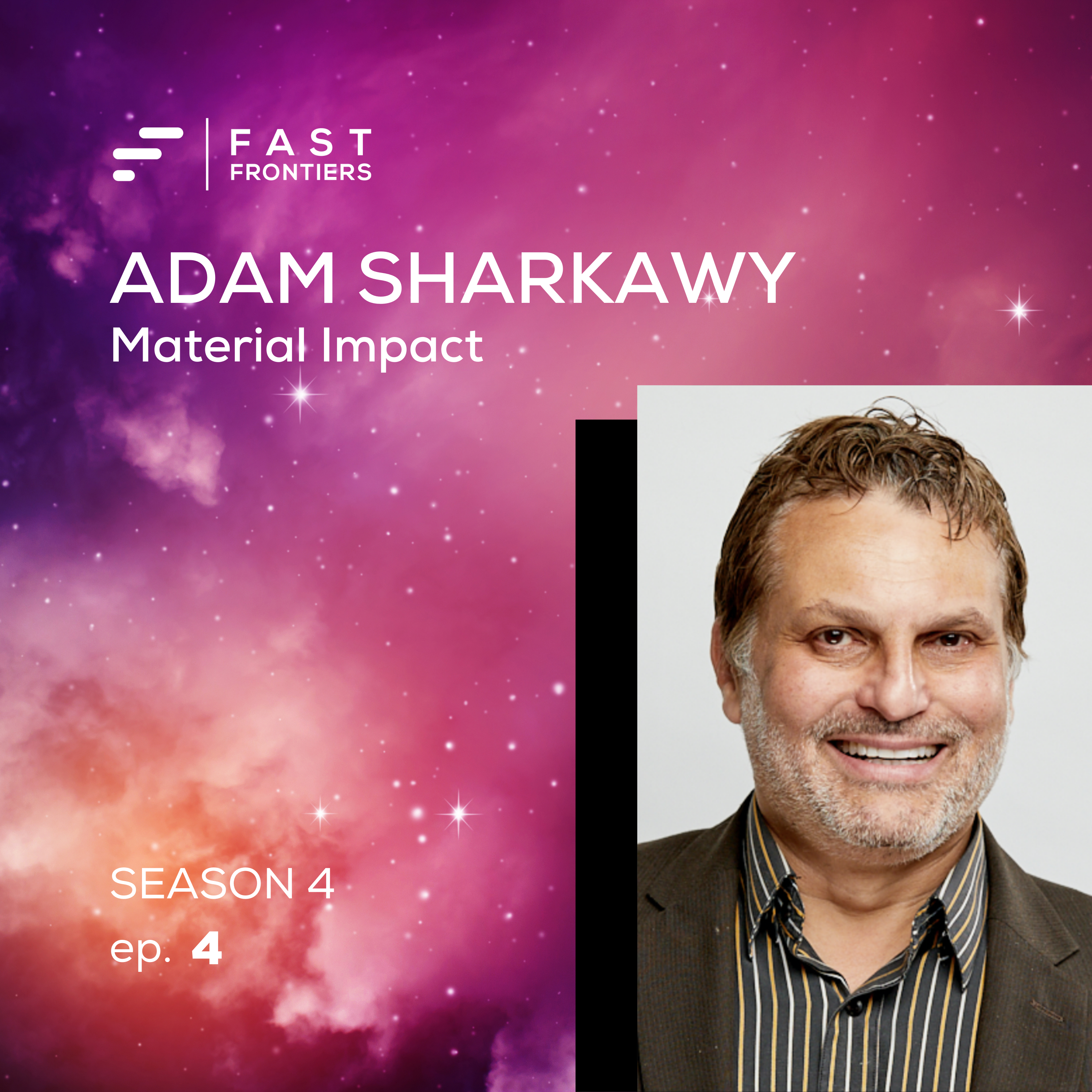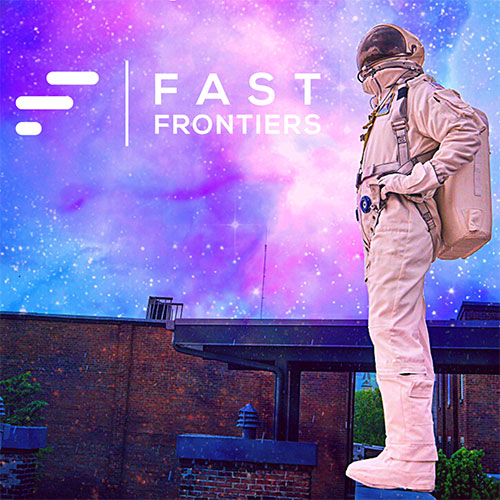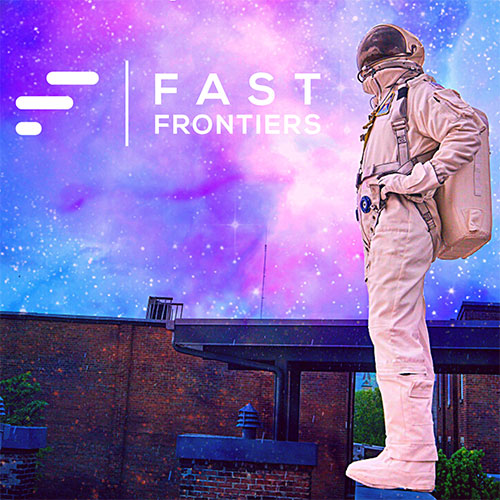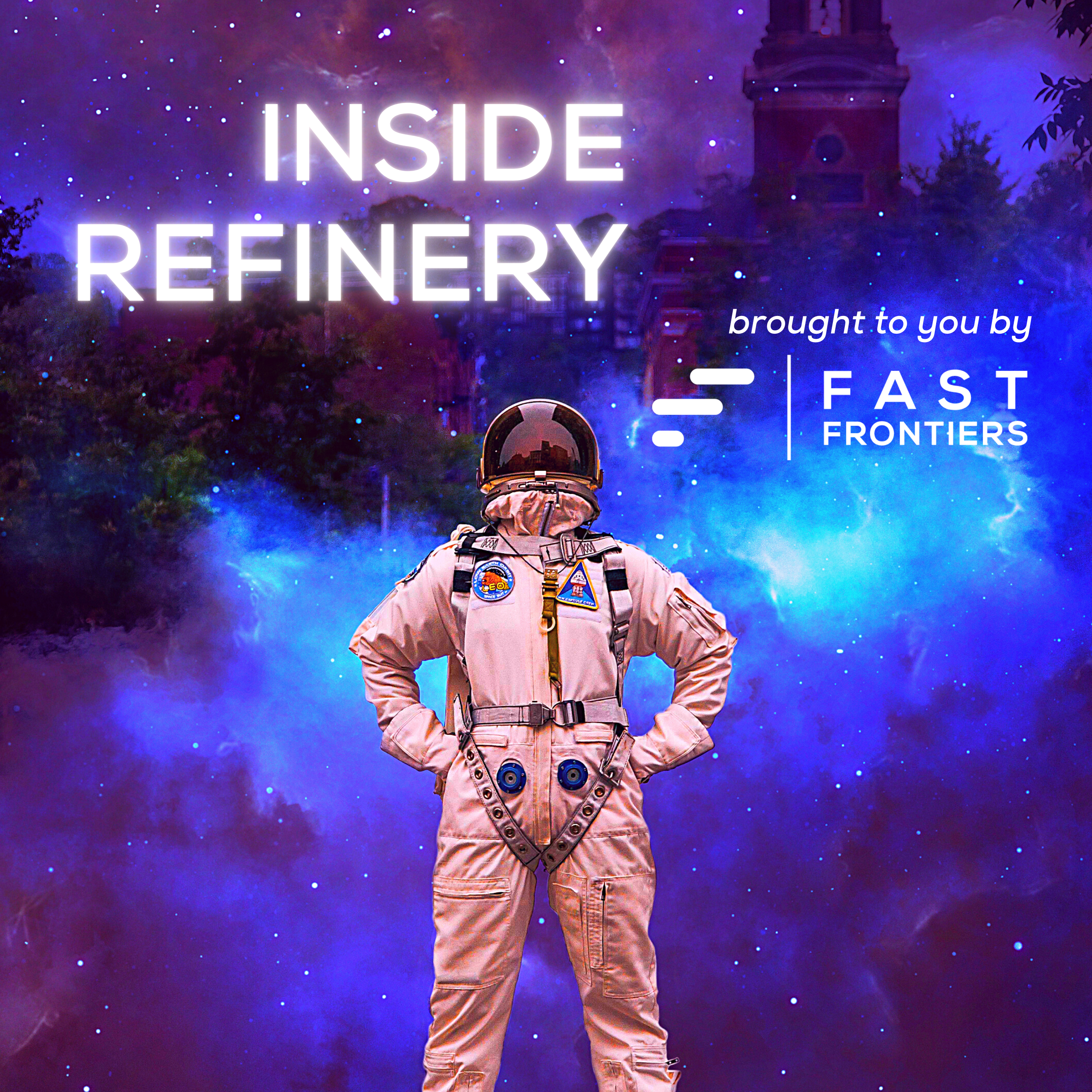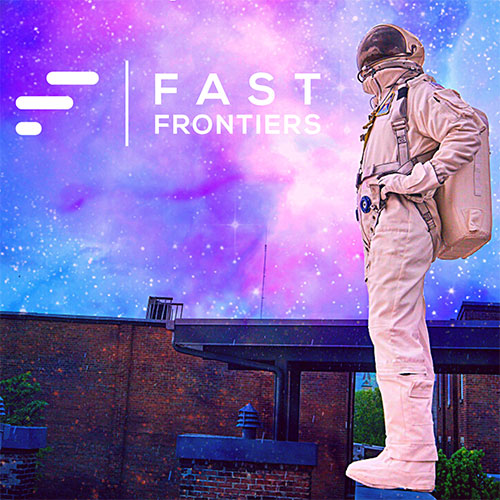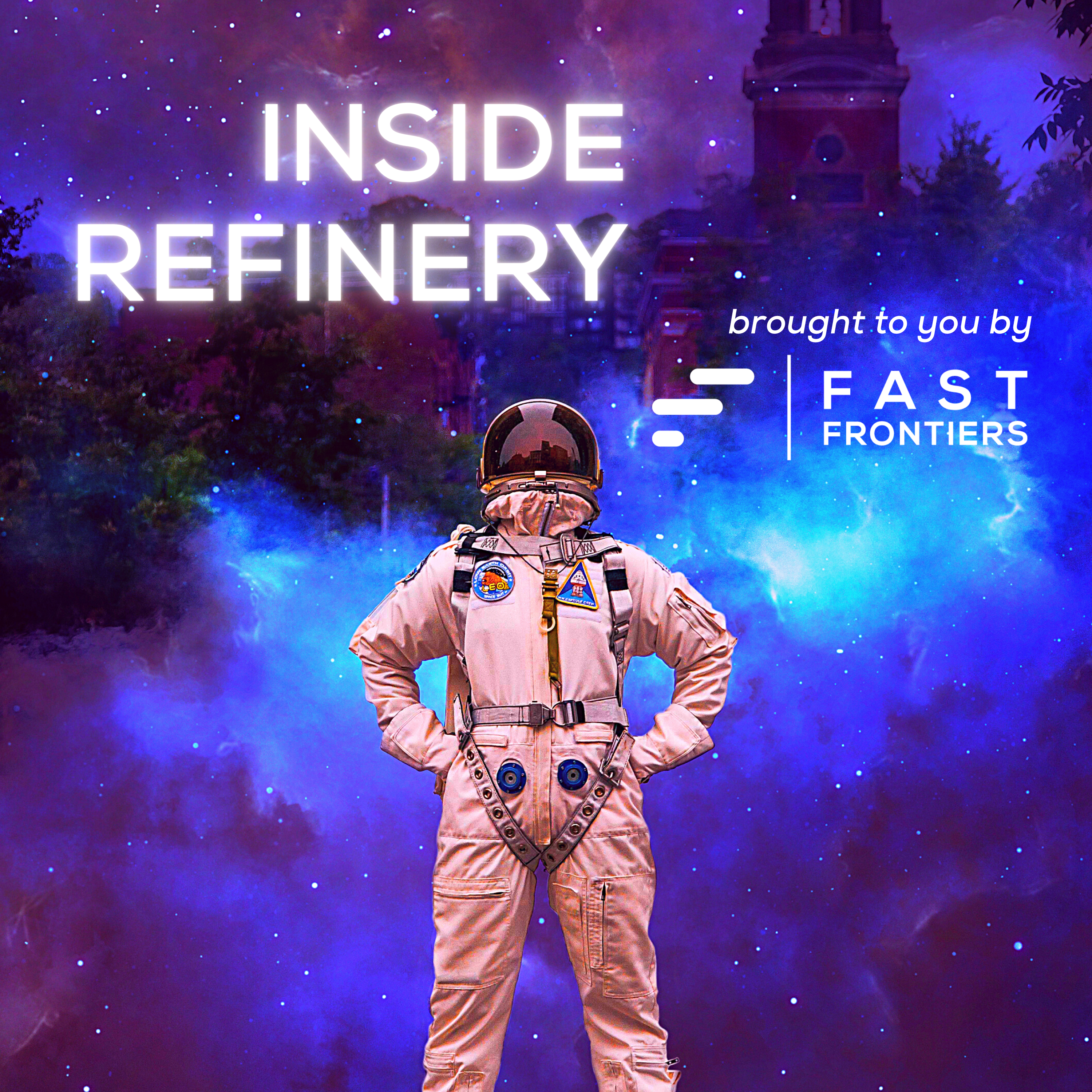S4 Ep 4. Adam Sharkawy: Material Impact
- 0.5
- 1
- 1.25
- 1.5
- 1.75
- 2
Tim Schigel: Welcome to Fast Frontiers. I'm your host, Tim Schigel, managing partner of Refinery Ventures. In this episode, we're talking with Adam Sharkawy. Adam is the co-founder and managing partner at Material Impact a venture fund located in Boston, Massachusetts. In this episode, we're going to dive into Adam's unique background and his career journey, which he calls his algorithm, which was going back to school after experiencing an exit at each startup he worked for. So he's been through his undergrad, a startup, had an exit, went back for his masters, had another startup, had an exit, got his PhD, was running corporate innovation, and now a venture fund. Material Impact focuses on deep tech innovation, and we share an investment in Folio Photonics. We also get big geeked out on chaos and complexity theory, and nonlinear systems, and discuss that some of the most interesting innovations come from the convergence of technology and business models. And that's where the cool stuff happens. The biggest theme or so what I hope you take away from this conversation is that whether you're pulling technology and intellectual property out of research universities, or corporate innovation processes or startups, they're all hard to do well, but when done correctly can be extremely disruptive and successful. Please enjoy my conversation with Adam Sharkawy. Hello, Adam. Welcome to Fast Frontiers.
Adam Sharkawy: Good morning, Tim. How are you?
Tim Schigel: Awesome. Talking about Fast Frontiers and innovation, Adam's partner at Material Impact on that leading edge of cool frontier hard tech, as some people call it. So I'm really looking forward to digging in, Adam, and sharing some of your wisdom and experience with our audience, but first, and maybe even more importantly, I think, your personal story is very interesting. So if you don't mind, I'd love to have you share some of that, because I think it probably does inform a lot of the way you think about the world and think about investing. So, yeah. Tell us a little bit about how you grew up and how you came to get into the venture capital business.
Adam Sharkawy: No. Great. Thank you. First of all, thank you for having me. It's really a pleasure. It's always a pleasure talking to you, but a pleasure to get an opportunity to share experiences and thoughts on a topic we both very much care for. But going backwards rewinding a little bit to my background. I was born in Cairo, and came to the US at the age of three to four. My dad, at the time, I think I came over for DuPont. So there's a little bit of a material lineage in our family, even though that was a little bit indirect, but when we moved to Delaware, I grew up in Delaware, basically from pre-K all the way to pre-med to the college. And it was a great little town in Newark, where we were basically living on campus. As a matter of fact, I would say that there was a period of my life where both my parents were working at the university of Delaware at one point in time. And basically after school, I just walk over to the student center and instead of babysitting, my mom would just drop me off with a bunch of heavy students. And I was kind of raised in the progressive seventies flower power generation. It was great. So it was just a great experience all around, but basically I decided that I wanted to also get back in touch with my roots. And so I went back to Egypt for a period of time, about a three and a half years. And there's a longer story behind that, but basically, to keep it somewhat brief, decided to do an engineering degree there, to give myself some justification for being there for few years. And it was really, to me, kind of a very seminal set of experiences for me, because as they say, need is the mother of invention, and it's a very different world in some of these emerging markets, where I would liken it to here in the US things are kind of macro functions. We kind of call them macro function. Everything that's kind of pre-packaged and ready for you to plug and play crosstalk.
Tim Schigel: ...macro function's equivalent to the easy button, right?
Adam Sharkawy: Exactly, exactly. And that is not the case in most of the emerging world, everything has to be done bottom up, man, from scratch. And so there's very little plug and play in anything. Certainly I saw so many things there that just influenced me in a way to really appreciate how innovative people were when they really needed to be when they didn't have these macro functions to call. And I can share some of those anecdotes with you, but in any case, so it wasn't just that I was doing engineering. It was, I was doing engineering and in an environment where innovation was almost baked into individualized efforts on a daily basis. And that, I think, really influenced me, but in any case, after finishing that, I decided to come back to the US and didn't, at the time we didn't have ties back to Delaware and thought, "Hey, let me pick a new venue and experience a new part of the US", and eeny, meeny, miny, moe, I chose San Francisco in the Bay Area, and the Silicon Valley was right in the middle of the chip boom. It was kind of the mid eighties and a lot of innovation in microelectronics. I went there and actually was trying to marry my love for both engineering and the life sciences. I got my first job in a medical device company that was a small startup that was really innovating the way that coronary artery disease, one of the largest health issues, was treated. It was the kind of the pioneering alternative to open chest surgery. So, it was the advent of the balloon catheter before catheters existed, which not only led to an interesting technology, but an entirely new practice called interventional cardiology, and a new kind of practitioner called the interventional cardiologists, that didn't exist at the time. So, it was a really cool opportunity to be part of that. Basically, I went through a series kind of for the first half of my career, I was a serial entrepreneur. And went through a series of this kind of algorithm between I was fortunate that every startup I was involved in got acquired. And so after every exit I would crosstalk.
Tim Schigel: ...that's not a given, that's not easy to do.
Adam Sharkawy: I was fortunate, but I decided to go back to school after every exit. So it became this algorithm that I developed. So after the first one got acquired by Eli Lilly, I ended up deciding to go back to school and studied something that had nothing to do with my career at the time. But it was of personal interest to me, which was chaos theory, and kind of the intersection between non-linear mathematics, fractals, and innovation. It was really eye-opening for me, because what I was doing more specifically was trying to figure out how to think non-linearly. How to, in the advent of certain problems, jumped out of the rut of quote unquote linear thinking and utilize chaos that basically allows for very simple solutions to complex problems with very complex dynamics, but very simple underlying governing equations and so forth. So what was that? It was a means to try to energize the innovation process through nonlinear thinking. And that was very seminal for me as well, but at the time, I didn't know it. I was just pursuing a personal interest. Finished that, went back to the Bay Area a second time, did another startup, that got acquired, and decided all right, crosstalk time to go back to school again. Ended up going back to Duke, did my PhD in biomedical engineering, and biomaterials. And after wrapping that up, went back to the Bay Area a third time, did another set of startups, one that was a spinoff from Stanford got acquired by Johnson & Johnson, another one that I started from scratch with a friend of mine that ended up getting acquired by Medtronic. And then decided to jump to the other side of the fence and try to get an understanding of almost the exact opposite of what I was doing. Which was instead of starting up small things and try to grow them to a certain point, and then selling off, is to run large scale businesses and try to acquire things and use those to bolt on and grow them to scale. So, I jumped to the, as I say, the dark world of corporate leadership and became members of leadership teams of really large corporate five... Fortune 500's in the healthcare field, companies like Guidant, and Abbott, and Smith & Nephew, and Medicines Company. Did that for about another 14 or 15 years. And through that course, I did a lot of acquisitions, and really was very fortunate, again, enough to have started to kind of develop my own thesis around how do you increase enterprise value through innovation from both sides of the fence, and developing my own thoughts around that. And so fast forward to around 2015 or so about six years ago, thought that I really wanted to go back to my entrepreneurial roots, but instead of doing so across one company, I thought it would be great to leverage experiences across many companies, and to do so in a way where we'd be able to help out younger, brighter entrepreneurs than us. Really take the Baton and change the world through their transformative technologies. And at the same time, a very good friend of mine, Carmichael Roberts, who we've known each other for about 20 something years from our PhD days at Duke, was also thinking about the next thing. And he and I were very similar in our backgrounds, I would say in the first half of our careers, both of us were entrepreneurs. When I went the world of corporate leadership, he went into the venture world, and I thought we're common to our core, but we have this complementarity as well. And so it will be great to join forces and start our own fund. And out of that was Material Impact. We started Material Impact in... We started kind of raising Material Impact in 2016, finished our first fund raise in 2017, closed at about 110 million. And out of that did a dozen or so companies, and then started our second fund. And it's funny, I'll just share this anecdote with you, we decided to start our second fund raise around the end of 2019. Did our first close for half that amount, half the target amount. At the time we were trying to raise 150. We raised about half of that, and did our first close at the last day of February, February 28th.
Tim Schigel: Wow. Timing is everything. Just like your acquisitions, Something about you, man.
Adam Sharkawy: But it goes both ways, Tim. Goes both ways because then everything changed. Everything flipped on its head the very next week, and I was, "Oh, my God, we have to raise the rest of this thing now. We're committed to 10 years. We've got to raise the rest of this thing." And so we put it into overdrive and we were very fortunate. We over-subscribed twice and finished at six months ahead of the schedule, and raised 205. And so it was a great experience.
Tim Schigel: That's awesome. So, tell us a little bit about... Material Impact's a very unique firm, and you guys have unique capabilities, but just share a little bit about that, your focus area and the kind of companies that you look for and stage.
Adam Sharkawy: Yeah. I would say three basic tenants to a Material Impact. The first tenant is that we're a deep tech fund that firmly believes, and hopefully at a time before we deep tech was on Vogue, but a deep tech fund, that firmly believes that you can trace back almost every disruption in any market or industry segment to an underlying material science enabler. And I give examples that pertain to alloying of metals to the automotive industry and what polymers have done almost everything, what composite materials have done to the airline industry, and what this funny little element called silicon has done to an entire valley, and to everything that we touch and do today. And so, that, I would say is the first tenant to our thesis. And we think that material science advancements unlock new engineering solutions and new engineer paradigms. So, that the laws of engineering continuously change based on the axioms of what material science allows. Even Newtonian mechanics change based on new material properties, right? So, that's one of our tenants. The second tenant is that we like to work on really large, unmet needs, in those basic... At the most basic level of society, of humankind. And I call those kind of Maslowvian needs. Needs at the lowest base of Maslow's shrine. So, the issues around water scarcity, and food supply chain, and underrepresented segments of healthcare, certain aspects of transportation, et cetera, et cetera. And the third time is really the reason why we started Material Impact in the first place, which is we get involved very, very intimately with our founders, where we spend a lot of time trying to leverage our own experiences to helping them build their companies. Which I realize is something that a lot of venture firms will say, but I'd like to think we take it to a new level. It's rare that a week goes by where I haven't spoken to almost every one of my CEOs and sometimes several times, and we're working together. It's not an update session. It's more working together on solving something. And so we have a very hands- on approach. We're shoulder to shoulder with our entrepreneurs, and we get involved so early that sometimes, as Carmichael would like to say, we're indistinguishable from the founder sometimes. inaudible
Tim Schigel: And you and Carmichael are great at that. And your backgrounds are perfect for that. So you're an incredible resource for founders and CEOs. And then the rest of your team also reflects that, I think, which is just terrific. First of all, to step back a second, disclosure, we're co-investors in a company, a very interesting company in Cleveland, out of Case Western Reserve called Folio Photonics started by Dr. Ken Singer, who was a Bell lab scientist and a researcher and professor at Case Western. And they are unlocking the power of optical technologies in a completely new way, in the ability to leverage florescence, and quantum dots, and others to massively increase the amount of storage available, and random access storage, which has become a huge problem when you look at Amazon, Google, Microsoft, the cloud, the amount of storage that's necessary, and that's accumulating is likely to lead to a data apocalypse. We just don't know where to put it. And we think Folio may be solving that problem. And so we appreciate you investing in that company with us.
Adam Sharkawy: I got to tell you, you've coined that term so well. I mean, I love that term, Tim. That's exactly... That's so descriptive of, I think the dynamics that we're seeing play out right now.
Tim Schigel: Yeah. It's amazing that people, for those who don't kind of understand or appreciate it, that funny cat video that you upload to Facebook, right? They have to store that somewhere. And a year or two later, you might want to show it to your friends or your family, and they have to get that photo or that video, which means that cannot store it offsite in some tape storage, which is historically where people stored archive data. It needs to be accessed relatively quickly. And we're talking about materials, we're coming to sort of end of life on a magnetic drives, right? Which also suck up a huge amount of energy, because they're always there spinning. And it's a big problem. And it's amazing. It's one of the biggest industries. It's kind of like death taxes and storage, right? I mean, storage isn't going to go away. We know that. It's only getting bigger and bigger and the world really doesn't know where the next generation, evolution of storage is going to come from. Many people talk about DNA storage, but that's still likely to be decades off where it can be used in production, right? So that's why we're both excited in what Folio offers and is another example, just for listeners in terms of understanding the kind of technologies that are out there that are being developed, that we're looking for, which are coming out of so many major research universities around the country, it's not just MIT and Stanford, right? This happens to be Case Western, but Carnegie Mellon and Michigan and Illinois and Purdue. I mean, there is so much out there that I think, you'd agree, entrepreneurs need to be paying attention to.
Adam Sharkawy: So, that's a very important topic you just brought up Tim. So, I'm glad you brought that up. So couldn't agree more. So, first of all, we'll take a step back and say, now, if you were to ask, what are some of the biggest sources of deep tech innovations and where do we, as Material Impact, really try to focus on a lot of our autonomous attention to? Definitely it's in university and academic institutions. For several reasons, first of all, there are some great technologies that can get the de- risked with a lot of non-dilutive funding, and over years and years of development through multiple generations of PhD students and post-docs, but in a way where they really are advanced, it's not like a science project. These are technologies now that are really being motivated, not by just blue sky research, but rather by some major problems that I think are becoming irrelevant. And we're seeing a lot of this, by the way, we're seeing a lot of inaudible... we're seeing more objective oriented and mission- oriented research than just typical blue sky research. So, that's one piece. So, great technologies that are being developed in academic institutions. But then to your point, I think a lot of attention is really focused on the coasts. And then to be even more specific, probably 75 to 80% is really focused in two areas on the coasts, and the New York, Boston corridor and the San Francisco corridor. And there are some incredibly great institutions in the middle of the country that are just underrepresented. So, to your point, we like to spend a lot of time in the Midwest, and the South, and we've done, I would say probably a good third, at least of our portfolio, maybe a little bit more than that, has come out of the Midwest and the South. We're still increasing that presence, but whether it's, like I said, Michigan, Ohio, Iowa, Texas, great institutions, great work that's being done that just isn't getting as much attention from the coastal investors. And so that becomes a kind of a clandestine part of our thesis is to spend a lot of time in those underrepresented regions.
Tim Schigel: Yeah. Hope I didn't shoot us in the foot by talking about this on a podcast, because I think this is like major secret that people don't really understand is that there's so much there, from an innovation standpoint, that has potential to be commercialized if you know how to do that. As I always say the reason you hear about so much stuff coming out of Stanford is because they have a lot of window shoppers, and crosstalk have a lot of entrepreneurs that know how to raise money that walk the halls and know the grad students and know how to pull stuff out and commercialize it.
Adam Sharkawy: Yep.
Tim Schigel: Carmichael had the VC background. You had the large company background, both approaching innovation in different ways. And I'm glad you brought the network effects, and nonlinear effects, chaos theory, et cetera, because my observation is that I hear more VC types talking about those topics and understanding those kinds of systems than I do the corporate side, but that may not be fair. So, how would you compare, and contrast the different kind of worldview from a venture capital standpoint versus corporate innovation standpoint?
Adam Sharkawy: And I'll maybe add a second part to your question, which is, and how do we specifically look at it as a subset of the venture? I would say that, in general, the corporate development, it has the following characteristics to it. First characteristic is, it's often driven by initiatives that will at least initially tie back to some sort of strategic imperative by that particular company, but often deviate over time. And what really large corporates are good at is developing a lot of IP, that they have the resources in every large corporate development group that I've been involved with. We had several IP attorneys that were resident that would do nothing but that. And they would work with the large external firms to actually prosecute patents. But all they did was they're dedicated to generating IP with the local development teams, and there were teams doing that. So, they're great at that, but the following itself, and they're great warehousing certain technologies to a certain point. And I would say one last thing is they're good at taking certain technologies and taking them through a structured kind of a stage gate process to define basically how they get advanced through voice of customer, and so forth. So those things are our strengths, I would say, of the corporate world. However, along with that come the following challenges. Number one, and things are slow, slow moving because there's a lot of cross functional and matrix decision- making. Secondly, is that things are budgeted in ways that, as you mentioned earlier, they're not necessarily always aligned to determining what is really the most relevant and doubling down on certain things. A lot of things were kind of taken en masse together. And sprinkled a little, a little funding for this little resourcing for that. Thirdly, is that, and this is probably the one that's the biggest challenge is that they're very, very vulnerable to leadership changes, which happen all the time. Whether it's a leadership change at the very top or at the chief technology officer or at the VP of R&D or the director of a certain program or the GM of a business, whatever it is, then you can get a this program stops, this program goes on, and things come back from the dead the Lazarus options, just a mish- mash of things that constantly are undergoing changes in direction and changes in pertinent to the imperatives. And that makes it very, very challenging.
Tim Schigel: It's interesting, because in the startup world, you have a founder, who's got skin in the game, right? There's a vision and there's a persistence, and there's a continuity of vision. And basically everything is at stake for that person, everything.
Adam Sharkawy: Exactly. Which is exactly the opposite of what I just described. So, it couldn't be more different. You have dedicated people. We're not going through major changes in leadership and strategy and this and that. They're focused on a certain objective, and they have skin in the game that's not just financial, that's personal, that's there's so many different aspects to their motivation. And so that combination is exactly the opposite of what I just described on the corporate side. So I would say that's a very clear contrast between the two approaches and there's a place for both, because one of the things that I find that could be really interesting is the ability to also mine things coming out of large corporate R&D centers that I've been developed to a certain point, and now are just sitting on the shelves. And I know you shared that interest. And so I think that we'll be doing more and more of that developing relationships that we've already started with some large corporates that have no banks of interesting technologies that just are sitting around in archives, because they met the end of the line because it was a leadership change or a strategy change.
Tim Schigel: Well, there's also been a huge increase in the amount of capital coming from corporate venture groups. So, I'm definitely interested in helping corporations figure out how to play this game. I think historically they haven't been super successful at it, some have. Intel, Google, others who've put major... I think the difference is they put major long- term dollars behind it and teams behind it, that gives them some of that continuity, but it's very hard to integrate with the rest of the corporation because the incentive structures are just going to be different, right? So, I'm curious to get your... So I have this friend I mentioned running a venture group in a company, new ventures group, and he asked me this question, we'll see what you think. As VCs, we apply the scale test right away as well in terms of, "Hey, is this a big market?" But we know there's a lot of milestones to hit before we start worrying about massive scale production, worldwide global distribution, right? Have you seen that as well?
Adam Sharkawy: Yeah, no, absolutely. Absolutely. And so, there's two sides to that coin. So the first side is what you just mentioned. And I kind of mentioned earlier, it's got to be something that moves the needle for a large corporate to take interest in a program in general. Outside of this new ventures type of model I'm referring to the typical corporate R&D. It's got to fit within one of two paradigms, either one, it's got to be this really large market opportunity that is going to be getting... It's going to move the needle for the entire organization. Or the flip side is the binary opposite of that, which also doesn't... Which is where most R&D dollars are actually spent. And that is incremental modifications for market share retention, right? And to get out of the hole paint it blue and call it new kind of mentality. That first one, which is something really, really disruptive you're right. Often they fail before they start, because there are very few things that pass that filter. And I think creating this combination of, "Hey, we need to work on some disruptive things that", and he was one of the keys, Tim, I know this sounds somewhat obvious, but you always have to be thinking about how to disrupt yourself. If you're in a market leadership position as a large corporate, your biggest concern, better damn well be how do you disrupt yourself? So, if someone else does. And that's the market leadership that you're enjoying you better protect that. And that's the best way to protect it, right?
Tim Schigel: The great part about like Jeff Bezos and Amazon with the day one philosophy. But the scale, premature scaling also turns out to be one of the biggest killers of startups. Now there've been studies that have shown the startups that fail are the ones that have too many people, and raise too much money too early, versus being lean, resourceful, and I often talk about the early phase is like test revenue versus scale revenue. The test revenue phase is optimizing to not optimizing for scale.
Adam Sharkawy: That's right.
Tim Schigel: And once you've learned enough to understand the unit economics and kind of confirm a lot of those things, then you can start putting jet fuel on it. But if you put poor jet fuel on and you don't know what you have, you're just going to blow it up.
Adam Sharkawy: Exactly right. And said another way also, it's a lot easier to make adjustments to, and I hate to use the word pivot, but just to make slight adjustments in direction when you're small and nimble than when you've got a lot of momentum, inertia people and money behind something. And so you're absolutely right. That's the time to be able to learn and adjust and refine, and then you scale.
Tim Schigel: So, we could talk for a whole other episode just on back to chaos and complexity and non- linear effects of systems. But I would like to ask you, what, in that kind of category, how does that... Have you seen anything new, recent, lately that has caught your attention that you applied to what you do?
Adam Sharkawy: I'll take a step back and just kind of off the cuff say that, and I hate to geek out too much on this, but basically nonlinearities occur at the convergence of things. When you have multiple variables at play, then you create order effects that are non-linear. And so when you take that thinking and you apply it towards what we do, together, collectively, and innovation, you find that some of the most interesting innovations, the most powerful, ones are really those that converge a technology with a new business model, or with a new service model, or a new sales model, or a combination of the above. The most interesting ones are actually not just convergences, they're almost codependent. When a technology unlocks a new business model or new business model unlocks new technology. That is where all the interesting stuff happens. And this is where deep tech is also interesting, Tim, it kind of goes back to the very first thing that we started talking about. The cool thing about deep tech is unlike biotech and unlike software, those two latter ones, the software and biotech are pretty well defined in terms of the algorithm of their development, and how they are commercialized. Fairly well-known. Now, in the biotech world, you do a phase one study, a phase, two study, either. Either gets sold then, or you go to phase three, and I mean, it's the same thing. Crank it over and over again. I've actually had brilliant entrepreneurs who are masters at the biotech world, come out and tell me, "I want to go into deep tech." Well, why?" Because I'm tired of this algorithm and it's, okay, I've been there, done that." Same thing with software in SAS. The model is... Commercialization models are pretty well-known. In deep tech, everyone is different, and a lot of them are custom tailored.
Tim Schigel: Interesting.
Adam Sharkawy: Right? I can tell you that in our portfolio companies, I don't think any two companies have a similar go-to-market strategy. Good, bad or indifferent again. And so that, to me, while it can be challenging to manage on one hand, as a venture firm, there's a lot of cross- pollination that we learn that we can then help transfer to our companies, but it goes back to the magic happens when you're able to marry new business models, new go-to-market strategies, new service models, new sales models, along with new technology.
Tim Schigel: Yeah. That's terrific. That convergence can allow you to transform an industry, not just participate in it, not just incrementally change it, but actually transform an industry because you have new business model that was enabled by some breakthrough technology, new technology. That's terrific. Adam, this was wonderful. Thank you very much for sharing your time and experience with us.
Adam Sharkawy: Tim, it was a pleasure. It is continuous pleasure to work with you. And I hope that outside of the one company disclosed Folio Photonics I hope there will be many more.
Tim Schigel: There'll be many more. Thank you my friend.
Adam Sharkawy: Thank you. You take care now.
Tim Schigel: Thanks for listening to Fast Frontiers. If you like our show and want to know more, check out our website, fastfrontiers.com. If you enjoyed this episode, please share it with others and give us a rating and review on your favorite podcast platform. Join us next week when we bring you my conversation with Stephany Lapierre, founder and CEO at Tealbook in Toronto Canada. The Fast Frontiers podcast is brought to you by Refinery Ventures. Our producer is Abby Fittes. Audio engineering by Astronomic Audio. Marketing, content, and social media support from Content Callout. And our podcast platform is Casted.
DESCRIPTION
Today we're talking with Adam Sharkawy. Adam is the co-founder and managing partner at Material Impact a venture fund located in Boston, Massachusetts. Material Impact focuses on deep tech innovation, and we share an investment in Folio Photonics. We get a bit geeked out on chaos and complexity theory, and nonlinear systems, and discuss that some of the most interesting innovations come from the convergence of technology and business models. And that's where the cool stuff happens. The biggest theme or so what I hope you take away from this conversation is that whether you're pulling technology and intellectual property out of research universities, or corporate innovation processes or startups, they're all hard to do well, but when done correctly can be extremely disruptive and successful.
Today's Host
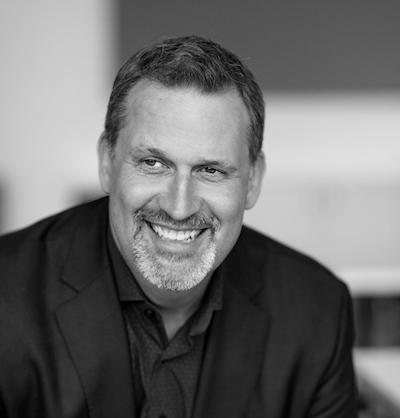
Tim Schigel
Today's Guests
